Every year friends and I go to see Atlantic spotted dolphins in Bimini and Grand Bahama with the Wild Dolphin Project – run by my friend, the brilliant and oft-published researcher Dr. Denise Herzing.
I rent the guest spaces on her catamaran Stenella, named after the genus of the dolphins, for either one or two of her 9-day expeditions every summer.
There’s a 4-bed guest cabin and a 2-bed guest cabin on the boat. One bed is pre-booked by my gear.
Denise knows, photographs, records sound and writes about dolphins she’s been studying for 35 years.
She also names the new calves.
Her focus is on dolphin “language” and especially on the spotted dolphins.
She and her team can identify about 300 spotted dolphins in the area, whether by memory or by photo ID.
Despite their main interest being the spotted dolphins, the WDP team also photographs the bottlenose dolphins we see from the surface and can identify some of those by their dorsal fins.
With the spotteds the team documents foraging, courtship, aggression, mother-calf behavior, travel and rest.
They track the dolphins’ reproduction and health, calving rates and pregnancy rates. And they collect fecal samples for DNA extraction and paternity.
We go in the water nearly every time spotted dolphins show up, and we try to observe them.
Some recognize Denise and her research assistants instantaneously, swim around them and play with them.
The dolphins are unpredictable (never aggressive with us) and all have their own independent characters and behavior. Some are bold, some shy, some inquisitive and playful. Some calves are cheeky and some mothers stern.
Sometimes you can observe them for a long time. We have often had encounters with familiar, friendly dolphins for an hour or more. Sometimes the dolphins immediately swim off when you get in… or the encounters are very short.
The average encounter lasts 20 minutes.
One day in 2018 we were lucky enough to swim with a dolphin called Monkey and another called Jammin’ for two hours and 55 minutes, over 3.15 miles ... on the very last day of our trip and right after we lifted the anchor to head home! The whole trip had been mediocre — nearly no “drops” or good swims for 9 days — and then a really long, life-changing, mind-blowing swim with two COMPLETELY active, interested, entertaining and playful animals. One of them spent ages playing with sargassum and swimming extremely close -- next to -- me, the other staying with the WDP crew behind me. Both swam intermittently among a huge group of jellyfish, often taking them in their mouths and playing with them.
Behavior varies… We frequently see them mating – so rude! Small groups playing; large groups traveling – busy cruising and disinterested in us; individuals looking for food in the sand et cetera.
The numbers of dolphins we see vary a lot as well. The most I ever saw in a group was 30, but they dispersed very fast into much smaller groups – as large groups nearly always do. Denise once got in, years ago, after the team guessed they had about 70 dolphins.
Some days we don’t spot a single dolphin.
Most of the time groups of 4-15 show up.
Denise has known some of the dolphins for over 15 years. One of the dolphins, who’s about 55, she’s known for her whole 35-year career.
The dolphins’ names include Arugula, Brush, Brat, Big Gash, Lettuce, Little Gash, Nassau, Palette, Picard, Soot, and Zeke. And of course: Monkey and Jammin’!
In November or December every year I go with friends to see spinner dolphins at Sataya in Egypt.
We rent a live-aboard boat called DIVE ONE that has 12 cabins and is mainly used for diving trips.
We go with my friend and guide Simone Piccoli, an Italian who shoots professional video[1] who has been living and working in Egypt for over a decade.
We anchor in the bay for 6 nights (though I now do two weeks there – with two different groups of people) and we swim with the dolphins every day, once for maybe 2-3 hours in the morning and then again for 2-3 hours in the afternoon.
We avoid the period between around 11 a.m. and 3 p.m. since “day boats” come from shore and put many more people – sometimes too many – in the water with the dolphins. Some of the dinghy captains drive badly and come too close to swimmers.
Often the swimmers are more like bobbing Muppets than capable people: many are clumsy or inexperienced swimmers.
Our group makes sure to be disciplined and spatially aware. We respect the dolphins tremendously (some don’t) and try not to kick each other in the face!
One hopes that the activity might become more regulated, the number of swimmers limited or rules of conduct imposed on both swimmers and dinghy captains, especially during peak hours.
There are between fifty and two hundred dolphins in the bay depending on the season. They come to rest and socialize during the daytime after hunting for squid off the reef at night.
We jump in with the animals from the 2 dinghies that live on the boat and tend to do multiple jumps in a row since the dolphins don’t usually stick around. Although they are habituated to people, the spinners in Sataya are much less interactive than the spotteds in the Bahamas. I’ve only seen a Sataya spinner really interact with someone, even for a few seconds, eight or nine times over four seasons.
As with the spotted dolphins, sometimes the spinners are swimming slowly, whether at the surface or down below… but sometimes they are swimming 4 times as fast as you can and the best you can do is watch them disappear into the distance or dive below you with a smile on your face.
Again like Bimini, the numbers vary.
Sometimes you see a whole group of 70 or more dolphins, sometimes ( the best of times) there are several groups of 20-40 around you. Invariably it’s the smaller groups of animals, frequently offshoots of a bigger group, that are most interesting to watch, that play with each other, mate, threaten each other or fight a bit amongst each other. These smaller groups are usually much more active and entertaining and make for better photographs.
Spotted dolphins and spinners are both from the same genus.
They are smaller and slenderer than the bottlenose one sees so frequently on tv. (Flipper was a bottlenose) and from boats the world over.
Whilst it’s sometimes hard to convince friends to fly to Egypt or the Bahamas and spend a week on a boat, most who have come once do repeat trips.
I personally wouldn’t give up the spotteds or the spinners for the world.
Just like with humpbacks in Tonga I think I will always go back to both places.
So long as the animals aren’t extinct and I’m alive…
1. He recently won multiple awards for a film about the whales in Tonga.
I rent the guest spaces on her catamaran Stenella, named after the genus of the dolphins, for either one or two of her 9-day expeditions every summer.
There’s a 4-bed guest cabin and a 2-bed guest cabin on the boat. One bed is pre-booked by my gear.
Denise knows, photographs, records sound and writes about dolphins she’s been studying for 35 years.
She also names the new calves.
Her focus is on dolphin “language” and especially on the spotted dolphins.
She and her team can identify about 300 spotted dolphins in the area, whether by memory or by photo ID.
Despite their main interest being the spotted dolphins, the WDP team also photographs the bottlenose dolphins we see from the surface and can identify some of those by their dorsal fins.
With the spotteds the team documents foraging, courtship, aggression, mother-calf behavior, travel and rest.
They track the dolphins’ reproduction and health, calving rates and pregnancy rates. And they collect fecal samples for DNA extraction and paternity.
We go in the water nearly every time spotted dolphins show up, and we try to observe them.
Some recognize Denise and her research assistants instantaneously, swim around them and play with them.
The dolphins are unpredictable (never aggressive with us) and all have their own independent characters and behavior. Some are bold, some shy, some inquisitive and playful. Some calves are cheeky and some mothers stern.
Sometimes you can observe them for a long time. We have often had encounters with familiar, friendly dolphins for an hour or more. Sometimes the dolphins immediately swim off when you get in… or the encounters are very short.
The average encounter lasts 20 minutes.
One day in 2018 we were lucky enough to swim with a dolphin called Monkey and another called Jammin’ for two hours and 55 minutes, over 3.15 miles ... on the very last day of our trip and right after we lifted the anchor to head home! The whole trip had been mediocre — nearly no “drops” or good swims for 9 days — and then a really long, life-changing, mind-blowing swim with two COMPLETELY active, interested, entertaining and playful animals. One of them spent ages playing with sargassum and swimming extremely close -- next to -- me, the other staying with the WDP crew behind me. Both swam intermittently among a huge group of jellyfish, often taking them in their mouths and playing with them.
Behavior varies… We frequently see them mating – so rude! Small groups playing; large groups traveling – busy cruising and disinterested in us; individuals looking for food in the sand et cetera.
The numbers of dolphins we see vary a lot as well. The most I ever saw in a group was 30, but they dispersed very fast into much smaller groups – as large groups nearly always do. Denise once got in, years ago, after the team guessed they had about 70 dolphins.
Some days we don’t spot a single dolphin.
Most of the time groups of 4-15 show up.
Denise has known some of the dolphins for over 15 years. One of the dolphins, who’s about 55, she’s known for her whole 35-year career.
The dolphins’ names include Arugula, Brush, Brat, Big Gash, Lettuce, Little Gash, Nassau, Palette, Picard, Soot, and Zeke. And of course: Monkey and Jammin’!
In November or December every year I go with friends to see spinner dolphins at Sataya in Egypt.
We rent a live-aboard boat called DIVE ONE that has 12 cabins and is mainly used for diving trips.
We go with my friend and guide Simone Piccoli, an Italian who shoots professional video[1] who has been living and working in Egypt for over a decade.
We anchor in the bay for 6 nights (though I now do two weeks there – with two different groups of people) and we swim with the dolphins every day, once for maybe 2-3 hours in the morning and then again for 2-3 hours in the afternoon.
We avoid the period between around 11 a.m. and 3 p.m. since “day boats” come from shore and put many more people – sometimes too many – in the water with the dolphins. Some of the dinghy captains drive badly and come too close to swimmers.
Often the swimmers are more like bobbing Muppets than capable people: many are clumsy or inexperienced swimmers.
Our group makes sure to be disciplined and spatially aware. We respect the dolphins tremendously (some don’t) and try not to kick each other in the face!
One hopes that the activity might become more regulated, the number of swimmers limited or rules of conduct imposed on both swimmers and dinghy captains, especially during peak hours.
There are between fifty and two hundred dolphins in the bay depending on the season. They come to rest and socialize during the daytime after hunting for squid off the reef at night.
We jump in with the animals from the 2 dinghies that live on the boat and tend to do multiple jumps in a row since the dolphins don’t usually stick around. Although they are habituated to people, the spinners in Sataya are much less interactive than the spotteds in the Bahamas. I’ve only seen a Sataya spinner really interact with someone, even for a few seconds, eight or nine times over four seasons.
As with the spotted dolphins, sometimes the spinners are swimming slowly, whether at the surface or down below… but sometimes they are swimming 4 times as fast as you can and the best you can do is watch them disappear into the distance or dive below you with a smile on your face.
Again like Bimini, the numbers vary.
Sometimes you see a whole group of 70 or more dolphins, sometimes ( the best of times) there are several groups of 20-40 around you. Invariably it’s the smaller groups of animals, frequently offshoots of a bigger group, that are most interesting to watch, that play with each other, mate, threaten each other or fight a bit amongst each other. These smaller groups are usually much more active and entertaining and make for better photographs.
Spotted dolphins and spinners are both from the same genus.
They are smaller and slenderer than the bottlenose one sees so frequently on tv. (Flipper was a bottlenose) and from boats the world over.
Whilst it’s sometimes hard to convince friends to fly to Egypt or the Bahamas and spend a week on a boat, most who have come once do repeat trips.
I personally wouldn’t give up the spotteds or the spinners for the world.
Just like with humpbacks in Tonga I think I will always go back to both places.
So long as the animals aren’t extinct and I’m alive…
1. He recently won multiple awards for a film about the whales in Tonga.
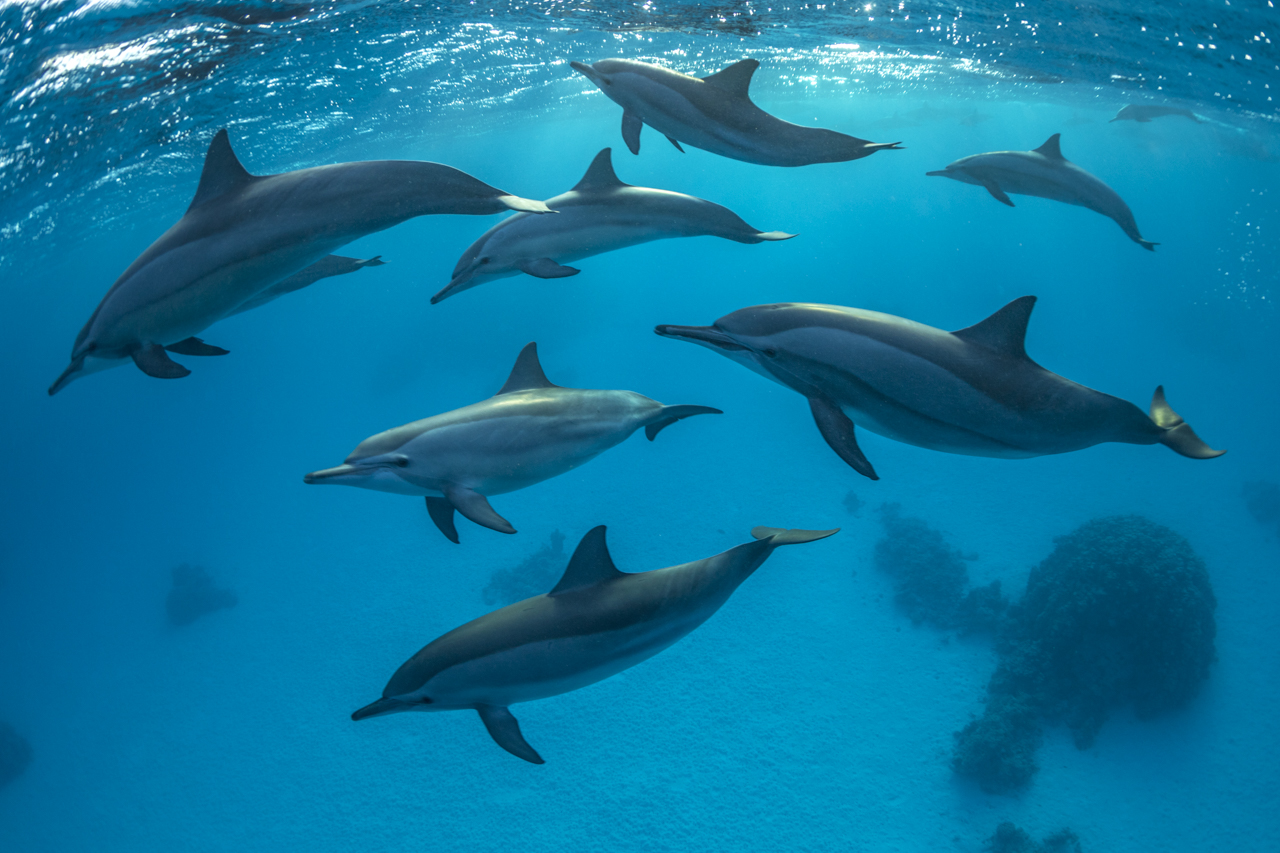
Magical moment or “positions”
Spinner dolphins of Sataya synchronised
Egypt, December 2016
It was as if the dolphins moved into position on cue!
A split second earlier and a split second later these guys were just “normal” dolphins in simple poses at the surface…
I was shooting so much that I hardly noticed what was happening in front of me. When you look through a screen all the time reality can seem detached. It was impossible to know this image would appear in my files.
There are two nearly identical versions of this photo, and it’s always interesting to see which frame people prefer.
Spinner dolphins of Sataya synchronised
Egypt, December 2016
It was as if the dolphins moved into position on cue!
A split second earlier and a split second later these guys were just “normal” dolphins in simple poses at the surface…
I was shooting so much that I hardly noticed what was happening in front of me. When you look through a screen all the time reality can seem detached. It was impossible to know this image would appear in my files.
There are two nearly identical versions of this photo, and it’s always interesting to see which frame people prefer.
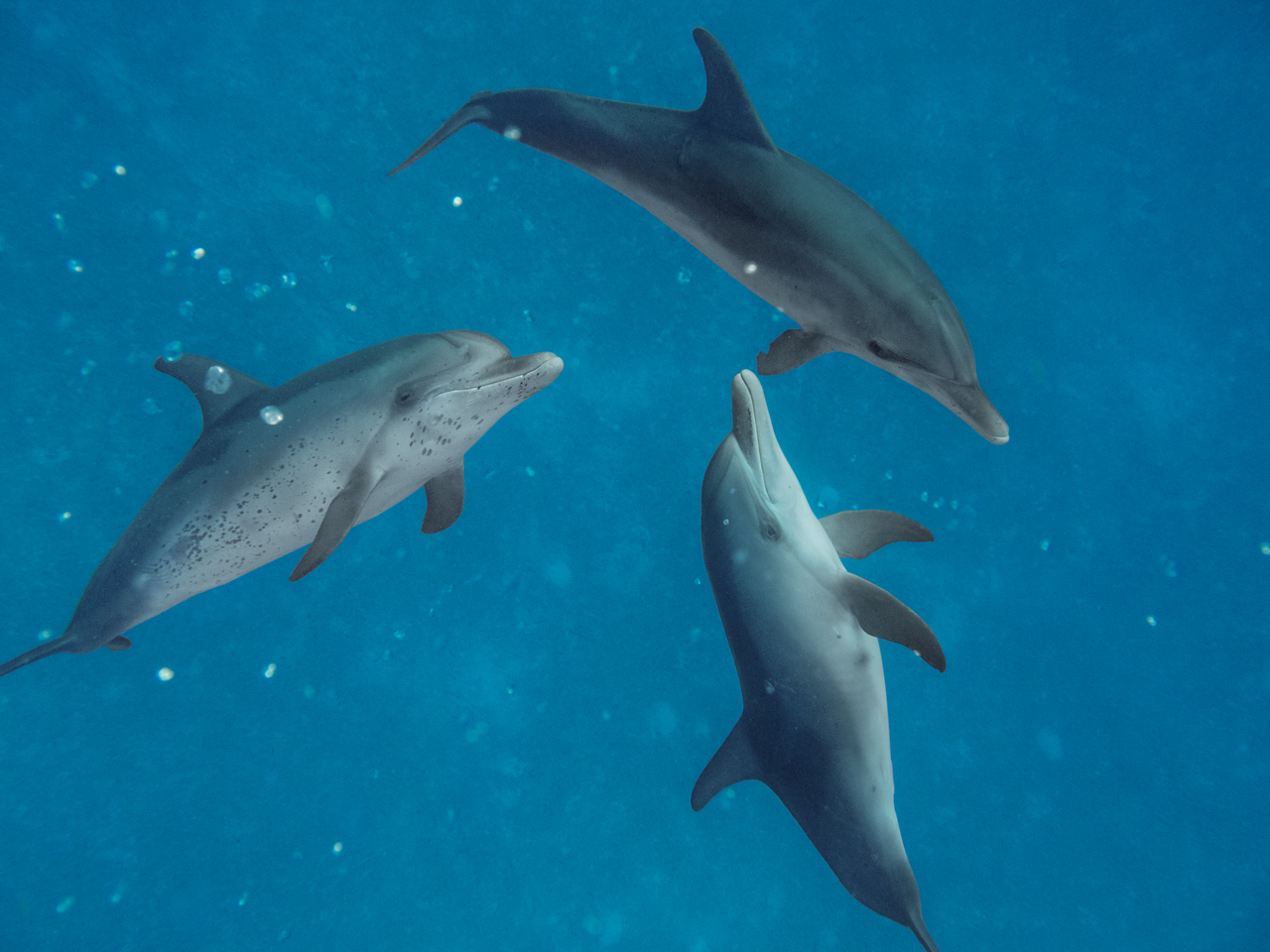
Trio of young Atlantic spotted dolphins
Bimini, The Bahamas, August 2013
16 or 23 – the number of dolphins that came in at one time.
My first encounter with more than 8 dolphins.
These were the loudest dolphins I’ve ever been in the water with – clicking and whistling and communicating the whole time.
The animals in this picture are probably an alliance of young males.
Larger groups nearly always divide into smaller factions, tighter sets of friends…
After at least nine 9-day trips with the Wild Dolphin Project, led by researcher Dr. Denise Herzing, since 2013, this is still one of my best images – and taken on my very first dolphin expedition.
I take thousands and thousands of photographs every trip, and it’s interesting to see which ones stand the test of time.
Bimini, The Bahamas, August 2013
16 or 23 – the number of dolphins that came in at one time.
My first encounter with more than 8 dolphins.
These were the loudest dolphins I’ve ever been in the water with – clicking and whistling and communicating the whole time.
The animals in this picture are probably an alliance of young males.
Larger groups nearly always divide into smaller factions, tighter sets of friends…
After at least nine 9-day trips with the Wild Dolphin Project, led by researcher Dr. Denise Herzing, since 2013, this is still one of my best images – and taken on my very first dolphin expedition.
I take thousands and thousands of photographs every trip, and it’s interesting to see which ones stand the test of time.
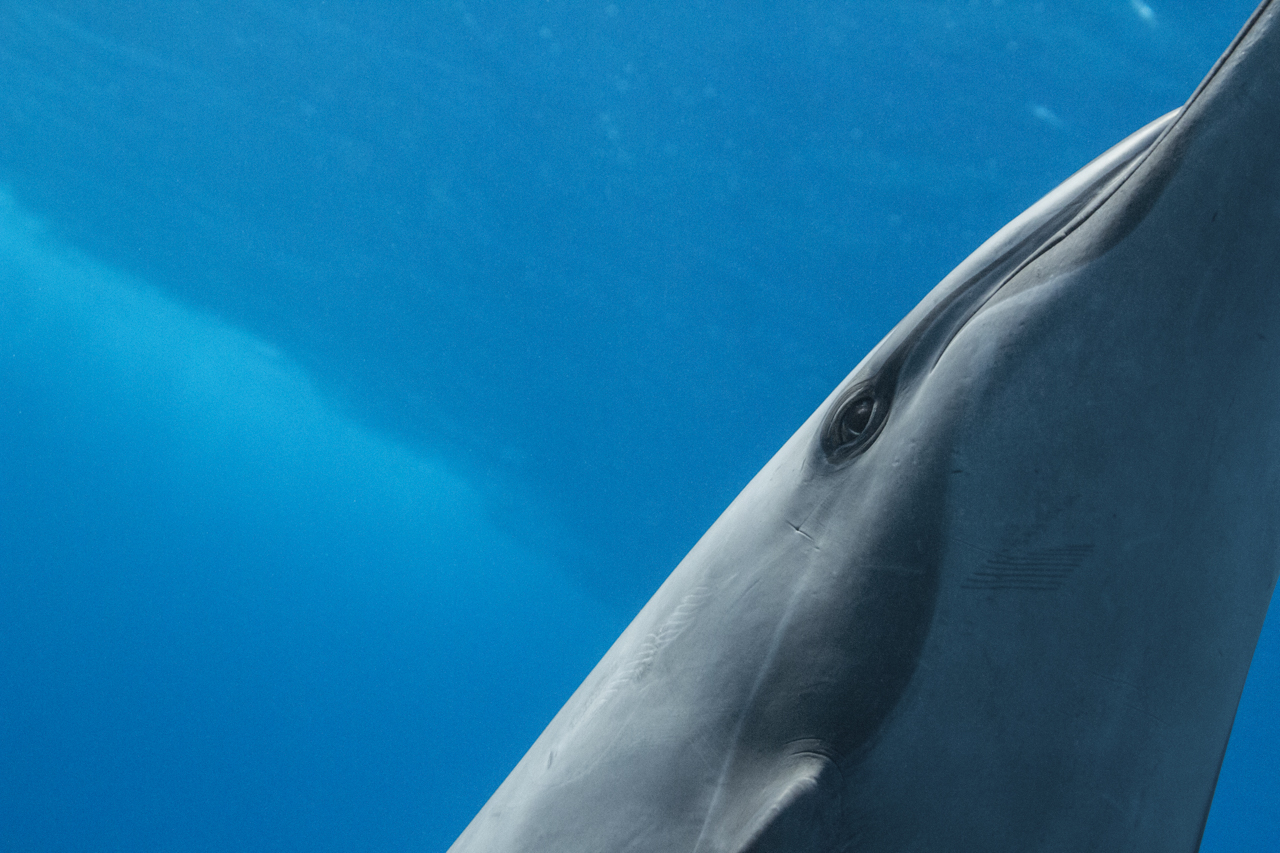
Spinner dolphin portrait taken as I was running out of breath
Sataya, Egypt, December 2014
This image is burned into my memory cells. Ingrained and encrusted in the corners of my mind and depths of my soul.
My lungs are incompetent!
A friend of mine managed to hold his breath for 3 whole minutes, his free diving instructor simply holding his back down at the surface, After only 2 classes!
Tom Peschak and so many admirable photographers can go to great depths and take magnificent photographs on one breath alone.
If only I could do that…
For me the limit is perhaps sixteen meters or 40 seconds!
For this image I had gone down below the surface – photographs look so much better when taken from below – and had the joy of a spinner rising directly towards my legs, eventually spiralling around them. My camera refused to shoot, and then refused again and again. And again.
The zoom must have been in the wrong position or light too low. Even as the dolphin rose higher, to my chest, and continued to spiral, I could not get an image of it! A shot would not go off.
And then, as I was seconds away from desperately needing air, the dolphin rose just above me — into the light. And I got this shot off.
I was CONVINCED the photograph would be a terrible failure, swimming back to the boat cursing my lungs, my camera and the light. (but not the dolphin!)
For sure I thought I might have half a fin, a head split in 2 or a throat without a face! But then, reviewing the images back on the boat, it was amazing to find what became my first book cover.
Sataya, Egypt, December 2014
This image is burned into my memory cells. Ingrained and encrusted in the corners of my mind and depths of my soul.
My lungs are incompetent!
A friend of mine managed to hold his breath for 3 whole minutes, his free diving instructor simply holding his back down at the surface, After only 2 classes!
Tom Peschak and so many admirable photographers can go to great depths and take magnificent photographs on one breath alone.
If only I could do that…
For me the limit is perhaps sixteen meters or 40 seconds!
For this image I had gone down below the surface – photographs look so much better when taken from below – and had the joy of a spinner rising directly towards my legs, eventually spiralling around them. My camera refused to shoot, and then refused again and again. And again.
The zoom must have been in the wrong position or light too low. Even as the dolphin rose higher, to my chest, and continued to spiral, I could not get an image of it! A shot would not go off.
And then, as I was seconds away from desperately needing air, the dolphin rose just above me — into the light. And I got this shot off.
I was CONVINCED the photograph would be a terrible failure, swimming back to the boat cursing my lungs, my camera and the light. (but not the dolphin!)
For sure I thought I might have half a fin, a head split in 2 or a throat without a face! But then, reviewing the images back on the boat, it was amazing to find what became my first book cover.
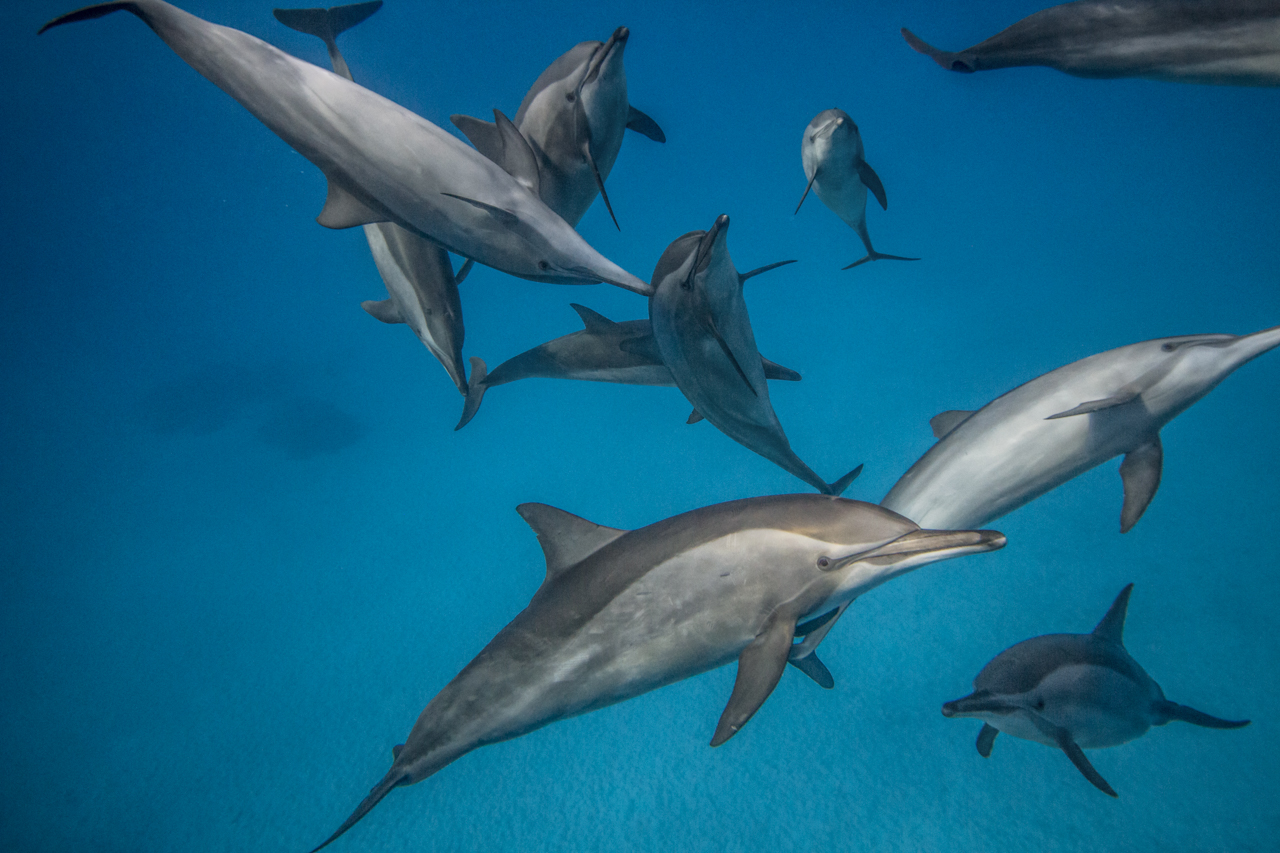
“Dolphin dance” – members of the Sataya pod
Sataya, Egypt, December 2014
One of my favourite photographs of all time.
From the first season in Sataya, invited on the boat by Cousteau’s ex video man – Didier Noirot.
Somehow everything fell into place as I clicked away.
Wonderful positions and angles, beautiful light, all in focus.
This photo has since been printed for multiple friends, my house and a silent auction at a charity dinner in New York.
Sataya, Egypt, December 2014
One of my favourite photographs of all time.
From the first season in Sataya, invited on the boat by Cousteau’s ex video man – Didier Noirot.
Somehow everything fell into place as I clicked away.
Wonderful positions and angles, beautiful light, all in focus.
This photo has since been printed for multiple friends, my house and a silent auction at a charity dinner in New York.
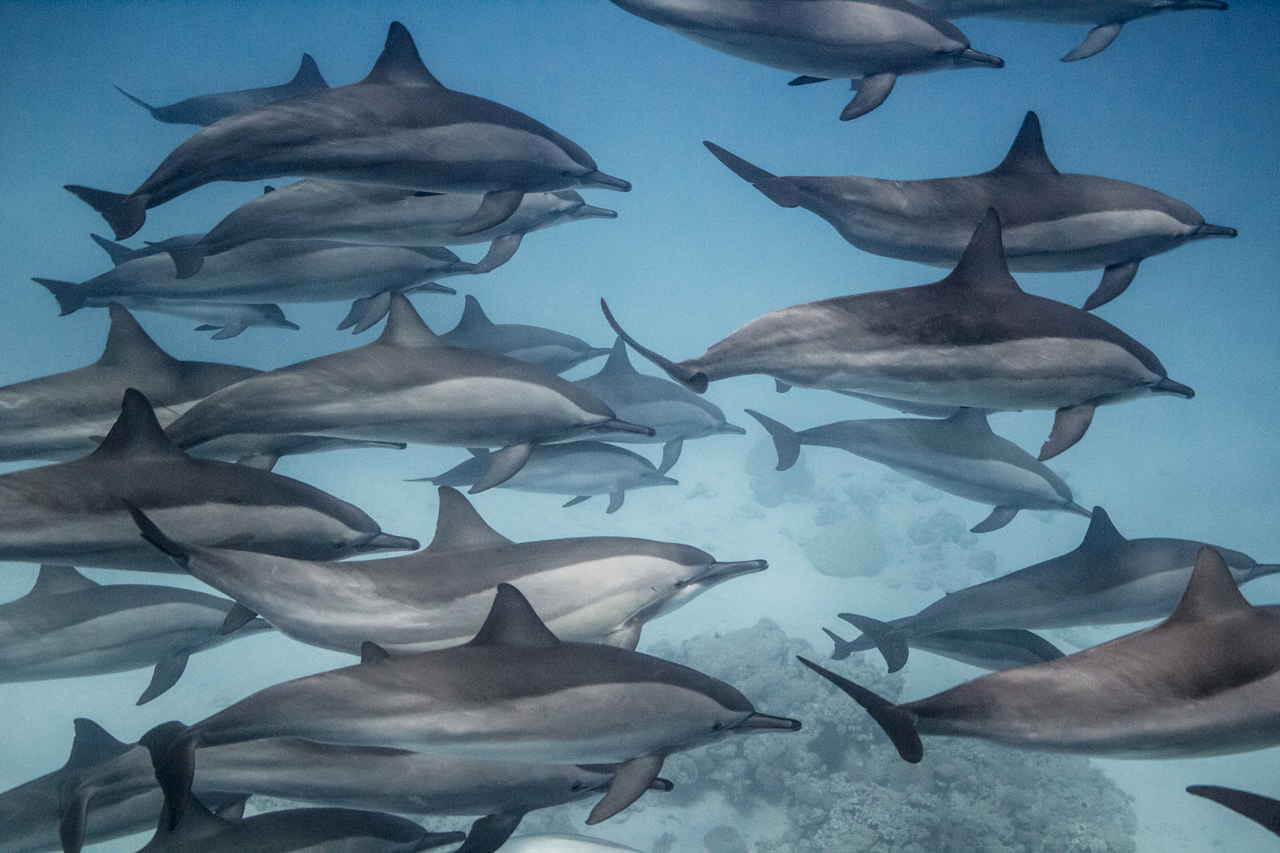
Multiple generations of spinner dolphins cruising over sand and isolated corals
Sataya, Egypt, December 2014
I’m always told this image looks more like a painting than a photograph. I don’t know why since the camera was on the same settings as the rest of the day and week.
Perhaps the natural light was different at that moment – overcast. Or maybe I was deeper, not at the surface. (one can’t dive with dolphins; only snorkel with them)
Sataya, Egypt, December 2014
I’m always told this image looks more like a painting than a photograph. I don’t know why since the camera was on the same settings as the rest of the day and week.
Perhaps the natural light was different at that moment – overcast. Or maybe I was deeper, not at the surface. (one can’t dive with dolphins; only snorkel with them)
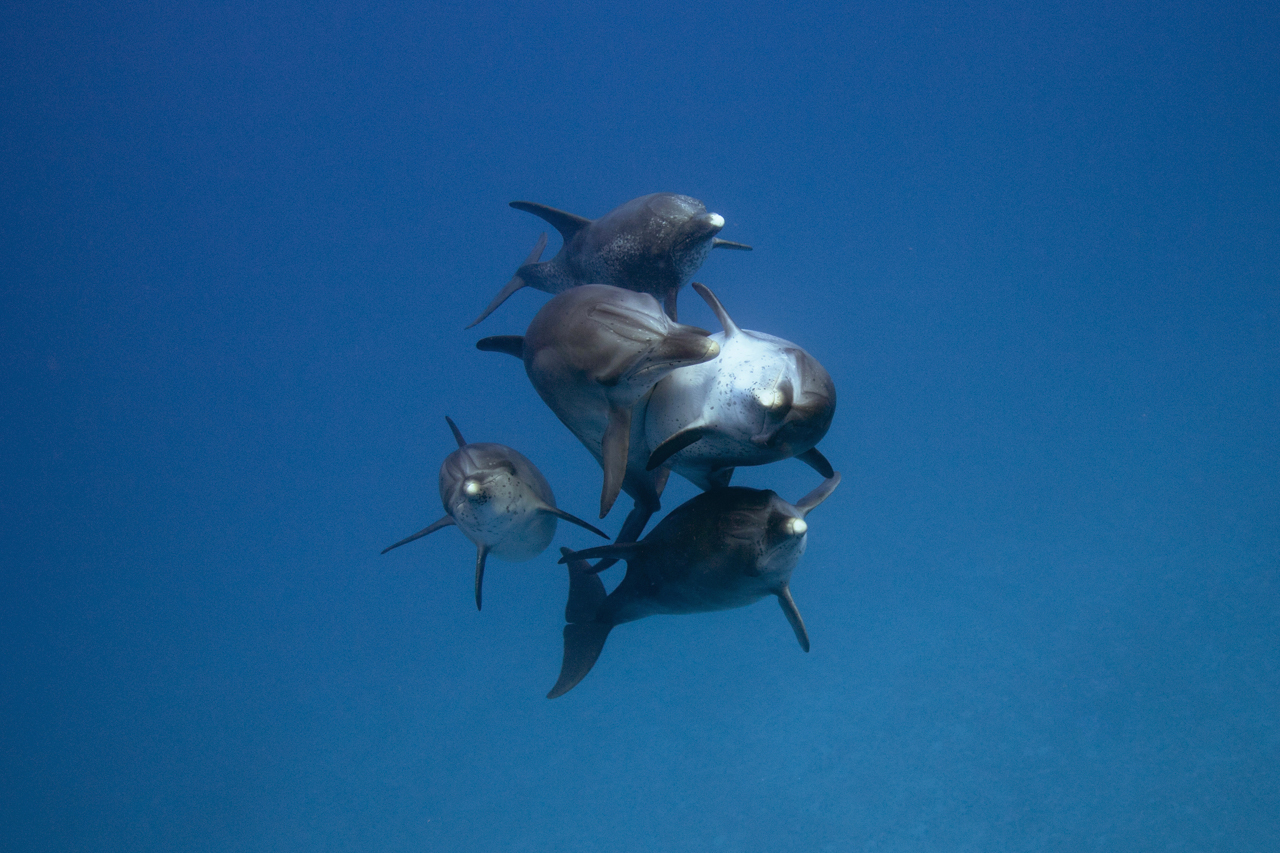
Rising As One --
Atlantic Spotted Dolphins
Bimini, The Bahamas, September 2015
Some shapes and positions just look so much better than others.
As animals start to come into view and as they get closer your excitement rises.
And even when you’ve seen some things a hundred times, as I have seen this, they continue to entice.
One nice thing about this image is how white the rostrums are — and the contrast that provides.
The shape formed by the middle dolphins, which seem to be mating, and the fact that all fins and tails are in different positions add more layers.
Atlantic Spotted Dolphins
Bimini, The Bahamas, September 2015
Some shapes and positions just look so much better than others.
As animals start to come into view and as they get closer your excitement rises.
And even when you’ve seen some things a hundred times, as I have seen this, they continue to entice.
One nice thing about this image is how white the rostrums are — and the contrast that provides.
The shape formed by the middle dolphins, which seem to be mating, and the fact that all fins and tails are in different positions add more layers.
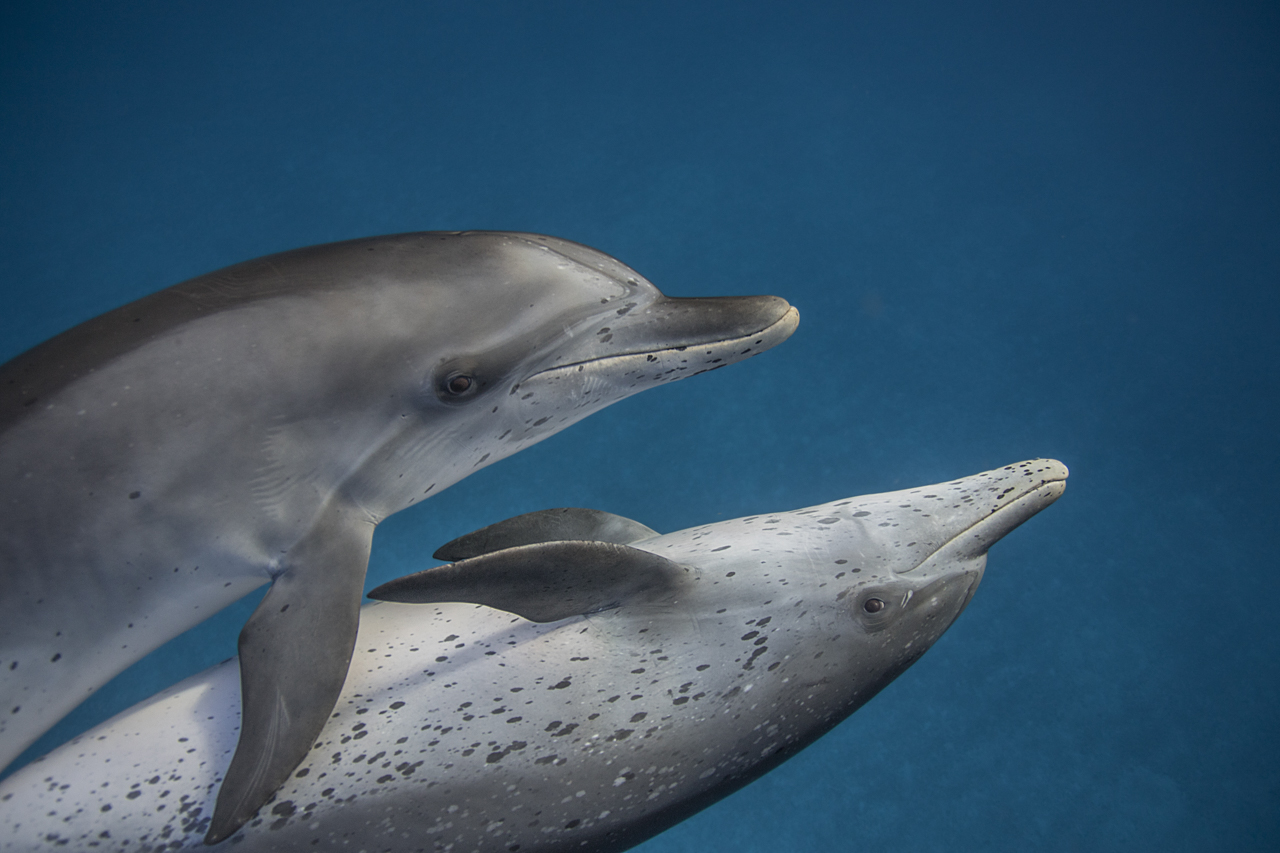
Dolphin love
Bimini, The Bahamas, September 2015
Atlantic spotted dolphins just as they were finishing mating…
It is the male who goes upside down when dolphins mate.
I shot a whole series as the couple rose to the surface, attached to each other, from the bottom about 10 meters down… but this frame,
one of the final images, turned out the best. Personally I wish more of their bodies appeared in the frame. But you work with what you’ve got.
Spotted dolphins acquire more spots as they age. Calves are born spotless. Spots begin to appear when the animals are about 4.
Once the spots are quite numerous the animals are described as being “mottled”, and when they are innumerable, and the animals older, the dolphins are said to be “fused”.
These 2 specific dolphins are from among the very large number Doctor Denise Herzing has been observing and swimming with in the Bahamas (and writing about) for 30 years.
She recognizes something like 100 different dolphins from memory and more from photographic files, and runs an organization called the Wild Dolphin Project. We met in 2013 when I joined Brian Skerry on her boat for the spotted dolphin part of his dolphin cover story in National Geographic.
The dolphins she studies split into two groups around 2013, one of the groups joining the more numerous Bimini animals, which has it made it harder for her to find and study them.
Regardless, for a tourist and animal-loving non-scientist every single moment spent with dolphins is a joy, a childhood dream come true, and a lesson in animal intelligence, socialization and healthy family structures!
There are plenty of operators in and close to Bimini who take clients to swim with these dolphins; but none are as well-versed as Denise and her graduate students, as close to and loved by the animals… Or as concerned about their wellbeing.
When you see this image don’t fool yourself into believing these animals mate for life or are madly in love. Dolphins are promiscuous and, along with apes, among the only animals who mate for pleasure.
Bimini, The Bahamas, September 2015
Atlantic spotted dolphins just as they were finishing mating…
It is the male who goes upside down when dolphins mate.
I shot a whole series as the couple rose to the surface, attached to each other, from the bottom about 10 meters down… but this frame,
one of the final images, turned out the best. Personally I wish more of their bodies appeared in the frame. But you work with what you’ve got.
Spotted dolphins acquire more spots as they age. Calves are born spotless. Spots begin to appear when the animals are about 4.
Once the spots are quite numerous the animals are described as being “mottled”, and when they are innumerable, and the animals older, the dolphins are said to be “fused”.
These 2 specific dolphins are from among the very large number Doctor Denise Herzing has been observing and swimming with in the Bahamas (and writing about) for 30 years.
She recognizes something like 100 different dolphins from memory and more from photographic files, and runs an organization called the Wild Dolphin Project. We met in 2013 when I joined Brian Skerry on her boat for the spotted dolphin part of his dolphin cover story in National Geographic.
The dolphins she studies split into two groups around 2013, one of the groups joining the more numerous Bimini animals, which has it made it harder for her to find and study them.
Regardless, for a tourist and animal-loving non-scientist every single moment spent with dolphins is a joy, a childhood dream come true, and a lesson in animal intelligence, socialization and healthy family structures!
There are plenty of operators in and close to Bimini who take clients to swim with these dolphins; but none are as well-versed as Denise and her graduate students, as close to and loved by the animals… Or as concerned about their wellbeing.
When you see this image don’t fool yourself into believing these animals mate for life or are madly in love. Dolphins are promiscuous and, along with apes, among the only animals who mate for pleasure.
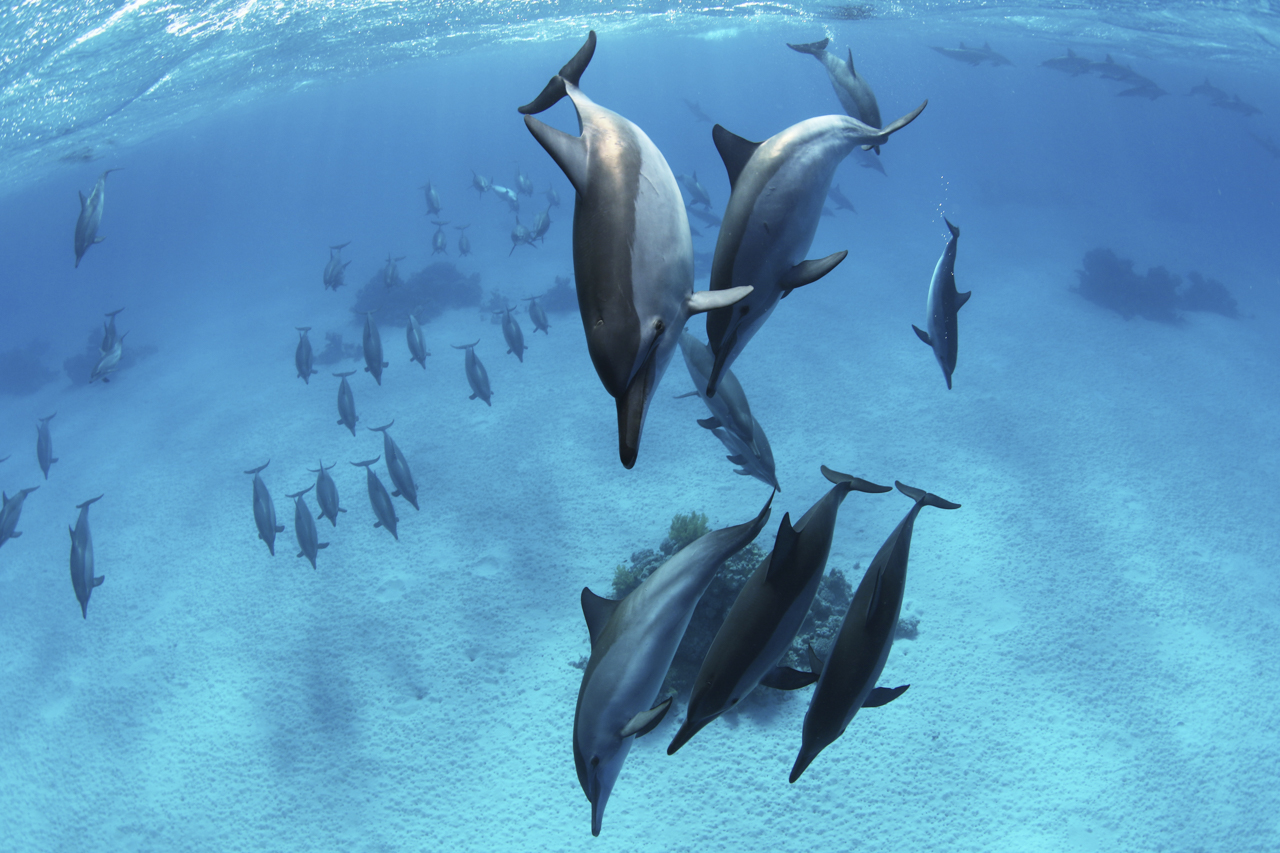
Seconds before the magic --
Spinner Dolphins
Sataya, Egypt, December 2016
If you compare this image to the main one from the DOLPHINS page of the Living Sea exhibition it should become obvious that this frame was taken seconds or less before “Magical moment or ‘positions’ ”, which is definitely one of the top 5 images in my dolphin portfolio.
Spinner Dolphins
Sataya, Egypt, December 2016
If you compare this image to the main one from the DOLPHINS page of the Living Sea exhibition it should become obvious that this frame was taken seconds or less before “Magical moment or ‘positions’ ”, which is definitely one of the top 5 images in my dolphin portfolio.
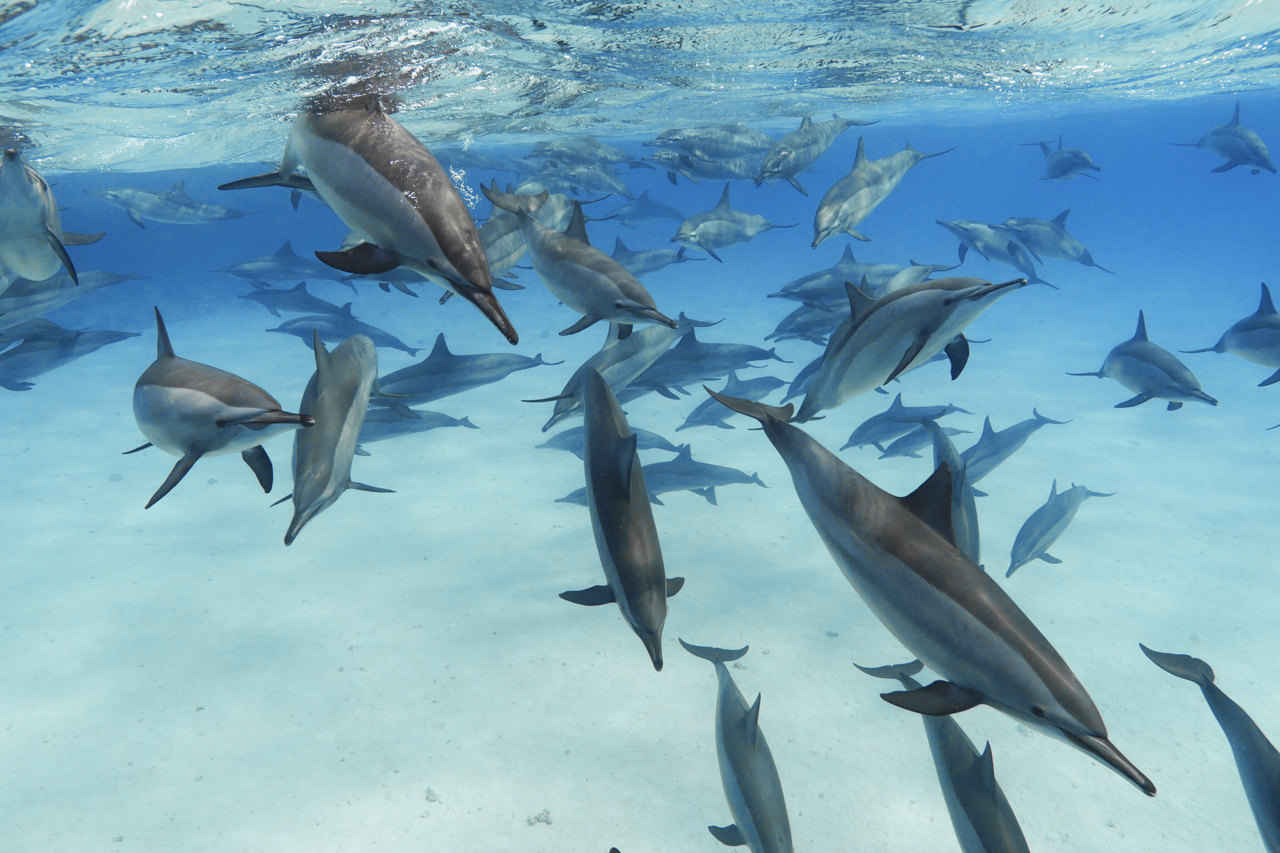
Coming from all directions with speed.
Spinner dolphins at Sataya, Egypt, in early December 2016
The spinner dolphins at Sataya, a tiny reef in the middle of nowhere which protects a bay in which spinner dolphins congregate, have become quite famous because they are habituated to human presence, can be found quite easily in the small bay, and are amazing to swim among.
Sometimes you see 80 dolphins in a tight-knit group. Sometimes you get close to a small number — an offshoot — of 6 to 12 individuals.
Sometimes the dolphins don’t want you there, stay 20 meters down and constantly swim away.
Other times you might be lucky enough to have dozens of spinners close to you and right at the surface.
Regardless of numbers and interactions, every hour in the water with dolphins — any dolphins — seems nearly miraculous, perfect dream or fantasy.
Sataya in Egypt, with its spinner dolphins, and Bimini in the Bahamas, with its Atlantic spotted dolphins, are 2 of my favorite places in the world, and the only locations I know of (though there may well be others) where one can swim with large numbers of confident, curious, beautiful (all dolphins are beautiful) habituated dolphins.
The idea that if you go into the water when you see dolphins they will come and play with you is largely a fallacy, an urban legend, a myth, a children’s story. Wild dolphins want nothing to do with you! Nineteen times out of 20 wild dolphins will swim as fast and as far away from you as they possibly can. And whilst this may seem like an enormous letdown — a broken dream or ruined myth — it is precisely what makes Sataya and Bimini so special.
Spinner dolphins at Sataya, Egypt, in early December 2016
The spinner dolphins at Sataya, a tiny reef in the middle of nowhere which protects a bay in which spinner dolphins congregate, have become quite famous because they are habituated to human presence, can be found quite easily in the small bay, and are amazing to swim among.
Sometimes you see 80 dolphins in a tight-knit group. Sometimes you get close to a small number — an offshoot — of 6 to 12 individuals.
Sometimes the dolphins don’t want you there, stay 20 meters down and constantly swim away.
Other times you might be lucky enough to have dozens of spinners close to you and right at the surface.
Regardless of numbers and interactions, every hour in the water with dolphins — any dolphins — seems nearly miraculous, perfect dream or fantasy.
Sataya in Egypt, with its spinner dolphins, and Bimini in the Bahamas, with its Atlantic spotted dolphins, are 2 of my favorite places in the world, and the only locations I know of (though there may well be others) where one can swim with large numbers of confident, curious, beautiful (all dolphins are beautiful) habituated dolphins.
The idea that if you go into the water when you see dolphins they will come and play with you is largely a fallacy, an urban legend, a myth, a children’s story. Wild dolphins want nothing to do with you! Nineteen times out of 20 wild dolphins will swim as fast and as far away from you as they possibly can. And whilst this may seem like an enormous letdown — a broken dream or ruined myth — it is precisely what makes Sataya and Bimini so special.
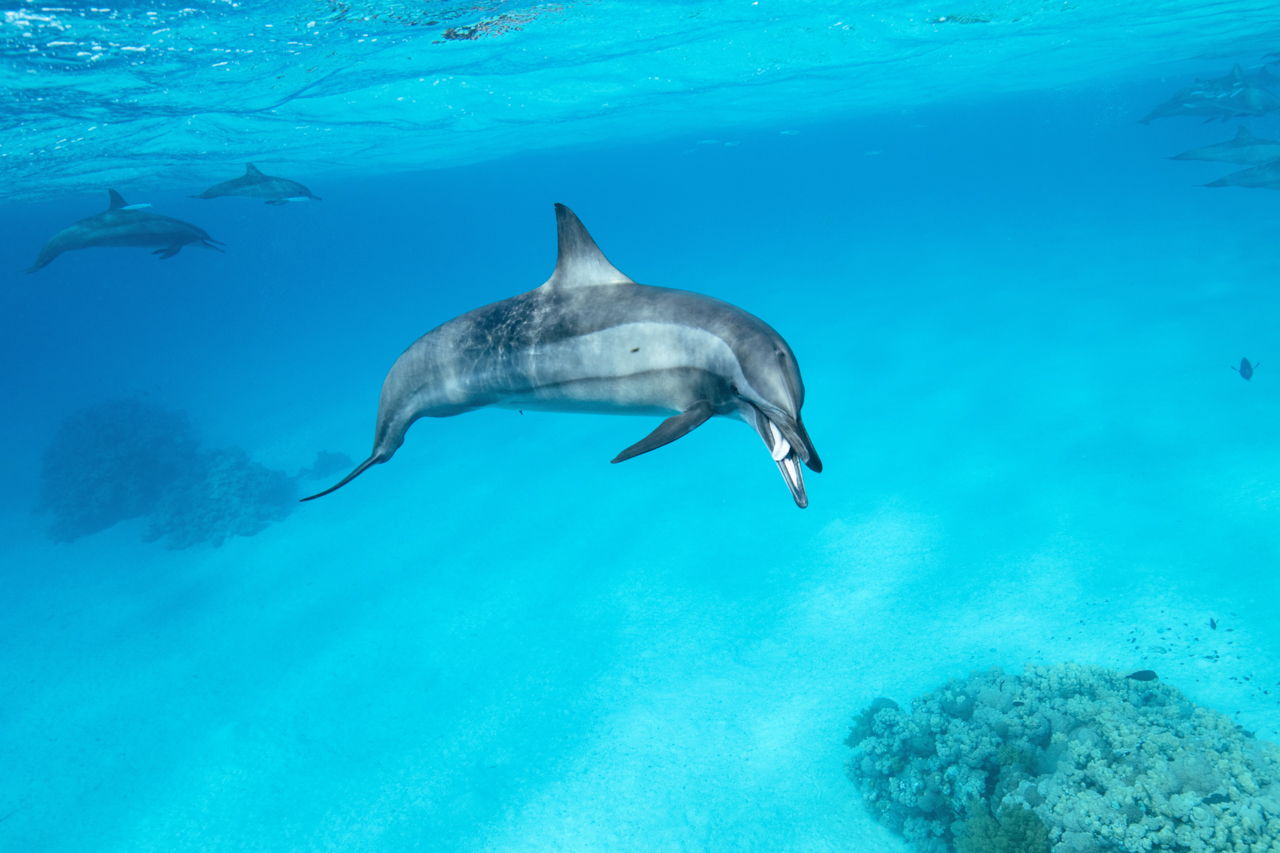
A spinner dolphin sticks its tongue out at me during an encounter at Sataya, December 2017

Bueno and Sycamore, young Atlantic Spotted Dolphins, playing in the waters of Bimini, July 2018
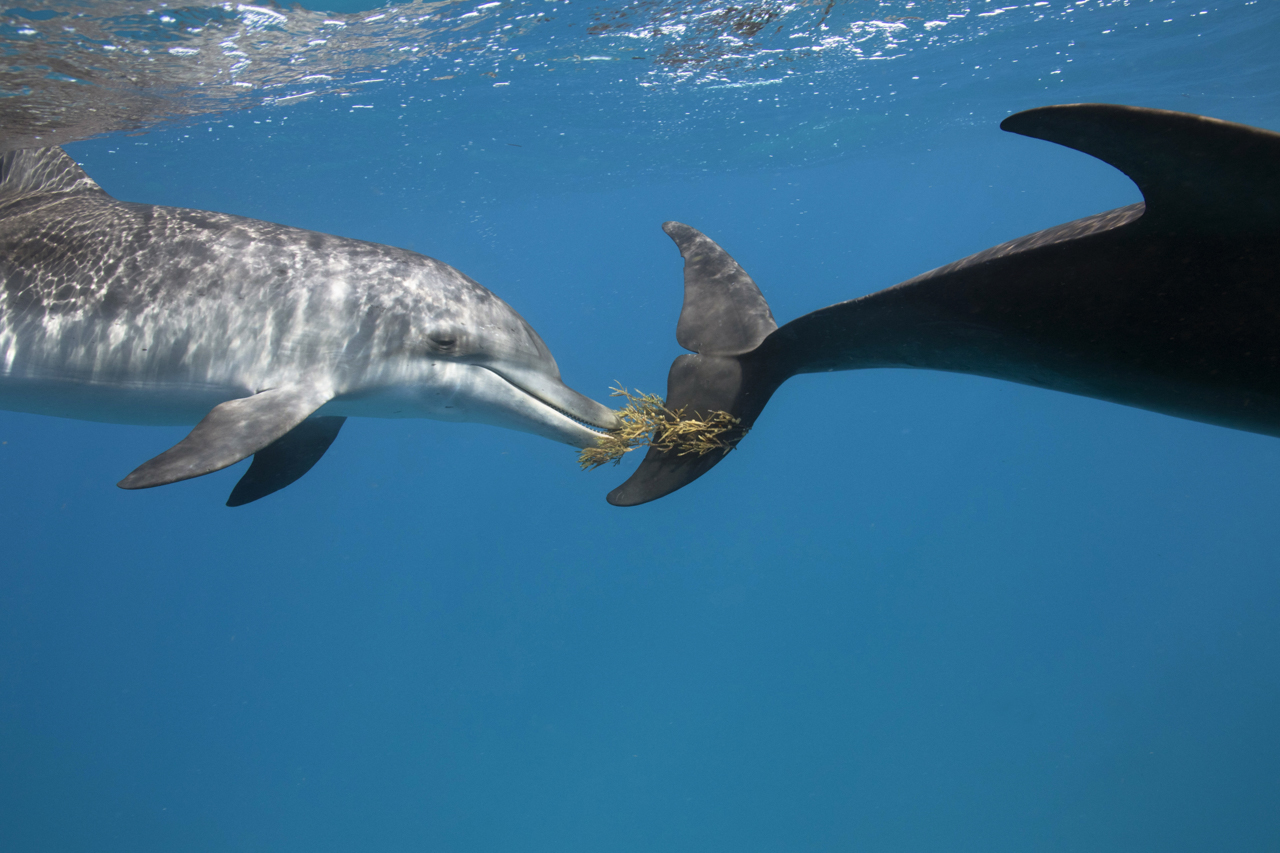
Monkey and Jammin, habituated Atlantic spotted dolphins, playing with sargassum.
Bimini, August 2018
On the very last day of a trip with few encounters, the dolphins appeared as we were bringing the anchor up, and I got to swim with them for 2 hours and 55 minutes over 3.15 miles!
Bimini, August 2018
On the very last day of a trip with few encounters, the dolphins appeared as we were bringing the anchor up, and I got to swim with them for 2 hours and 55 minutes over 3.15 miles!
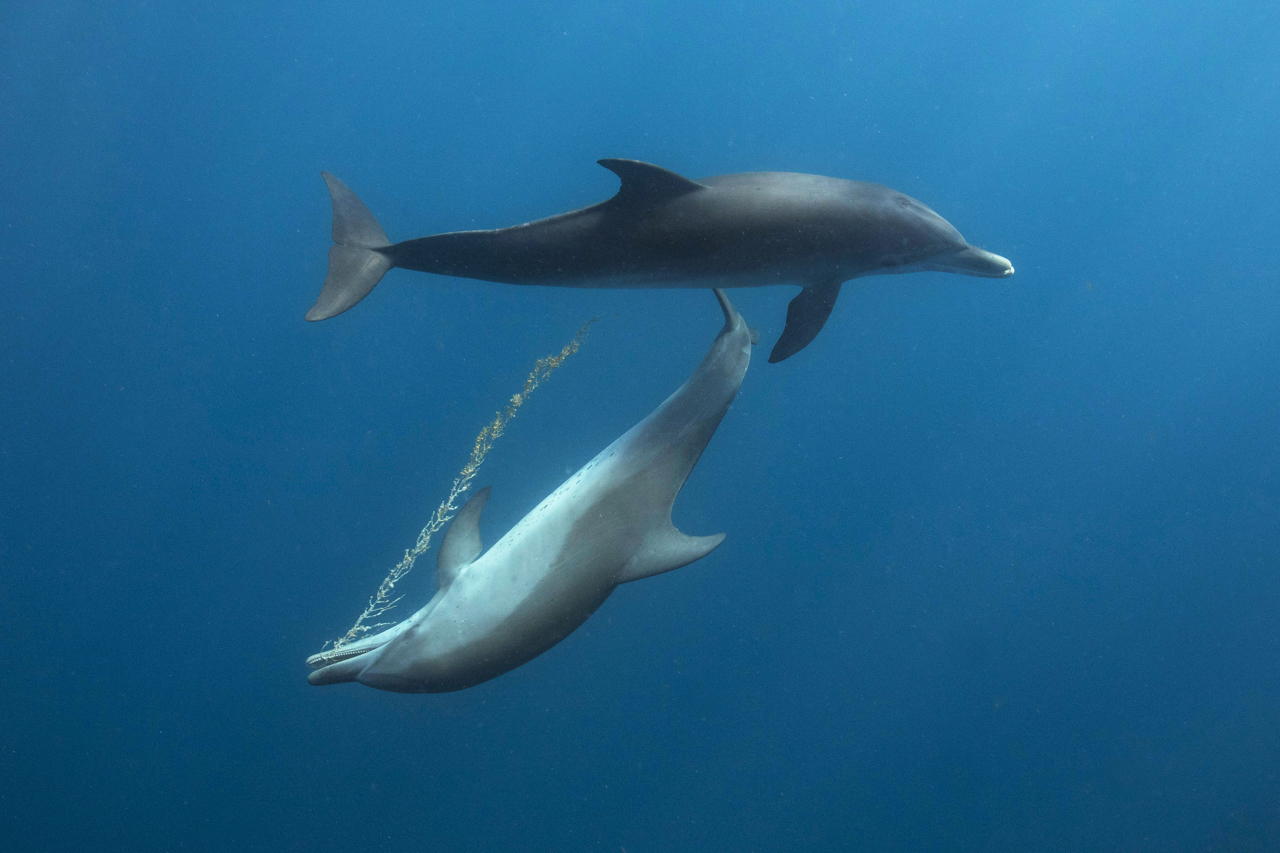
Monkey and Jammin, young Atlantic spotted dolphins very familiar to my friends at the Wild Dolphin Project, play with sargassum.
Bimini, Bahamas, August 2018
Bimini, Bahamas, August 2018
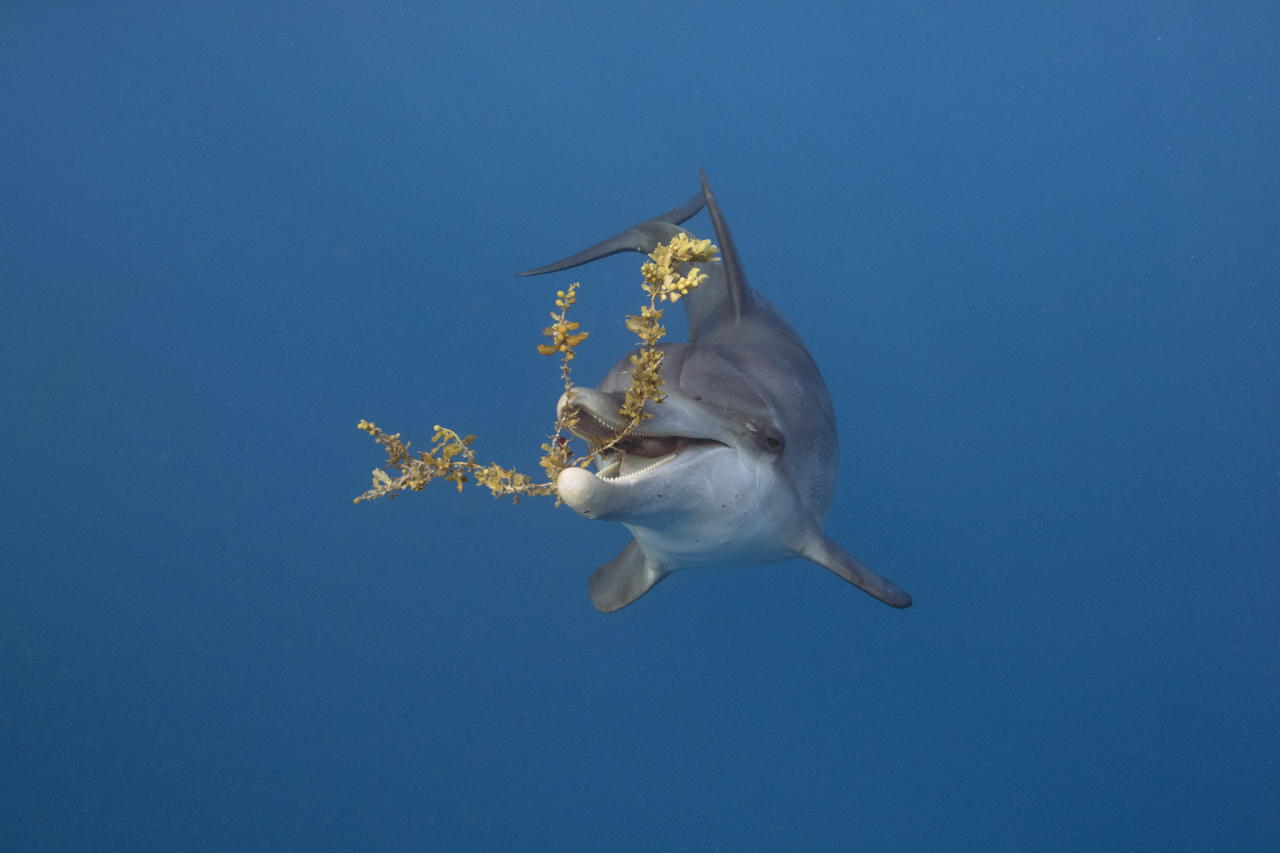
Young Atlantic Spotted Dolphin, “Monkey” or “Jammin”, playing with sargassum
And posing for me!
Bimini, August 2018
After a difficult trip with few swims, we had the 2 dolphins for about two hours and 55 minutes over about a 3-mile swim ON THE LAST DAY. They played with sargassum and jellyfish, interacting with us a lot — giving us sargassum and taking it from us, swimming around us...
I had Jammin by my side, eye to eye, staying right next to me for a bit while Monkey swam between everyone else a little further behind.
It was worth the wait — and these 2 animals more playful and interactive than one would imagine possible.
Full of joy...
And posing for me!
Bimini, August 2018
After a difficult trip with few swims, we had the 2 dolphins for about two hours and 55 minutes over about a 3-mile swim ON THE LAST DAY. They played with sargassum and jellyfish, interacting with us a lot — giving us sargassum and taking it from us, swimming around us...
I had Jammin by my side, eye to eye, staying right next to me for a bit while Monkey swam between everyone else a little further behind.
It was worth the wait — and these 2 animals more playful and interactive than one would imagine possible.
Full of joy...
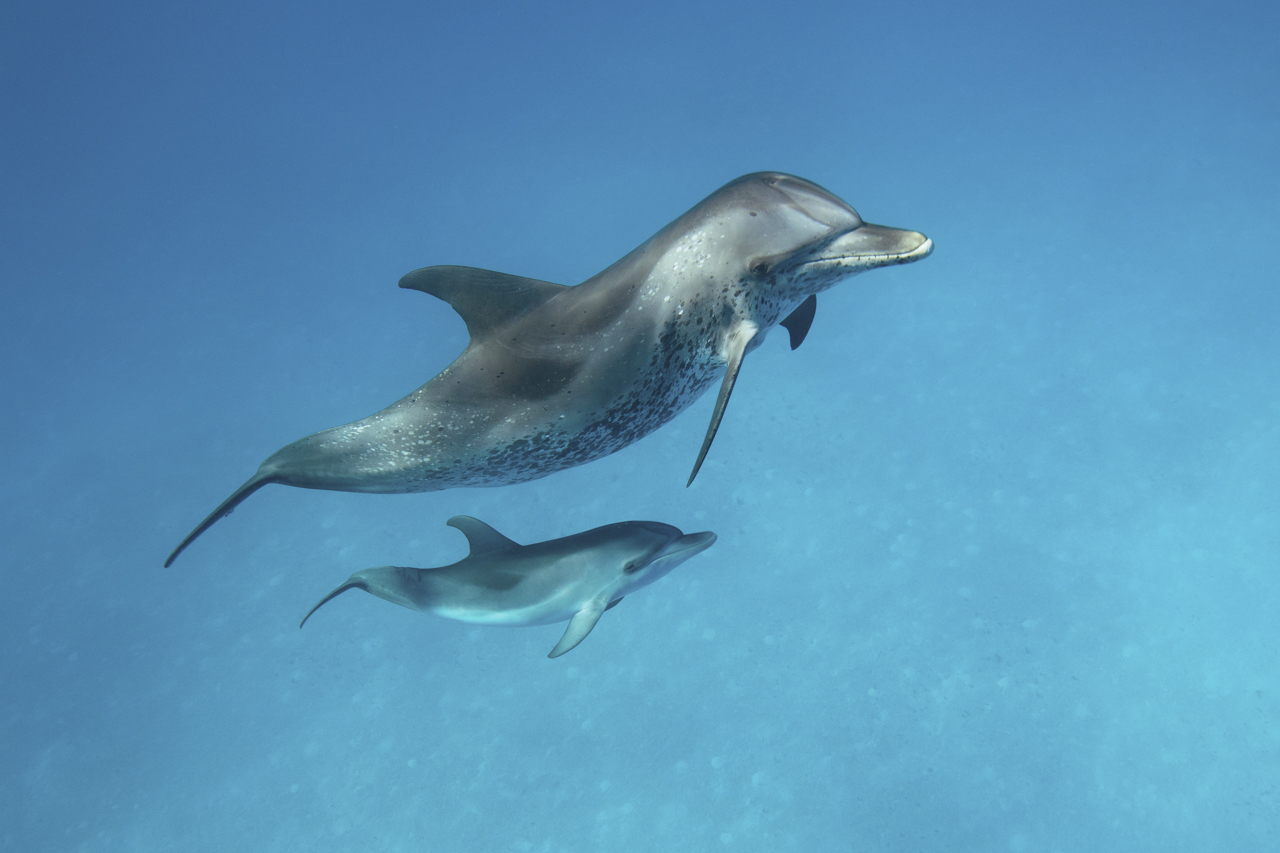
Mother and calf — Atlantic Spotted Dolphins
Bimini, Bahamas, July 2019
Bimini, Bahamas, July 2019
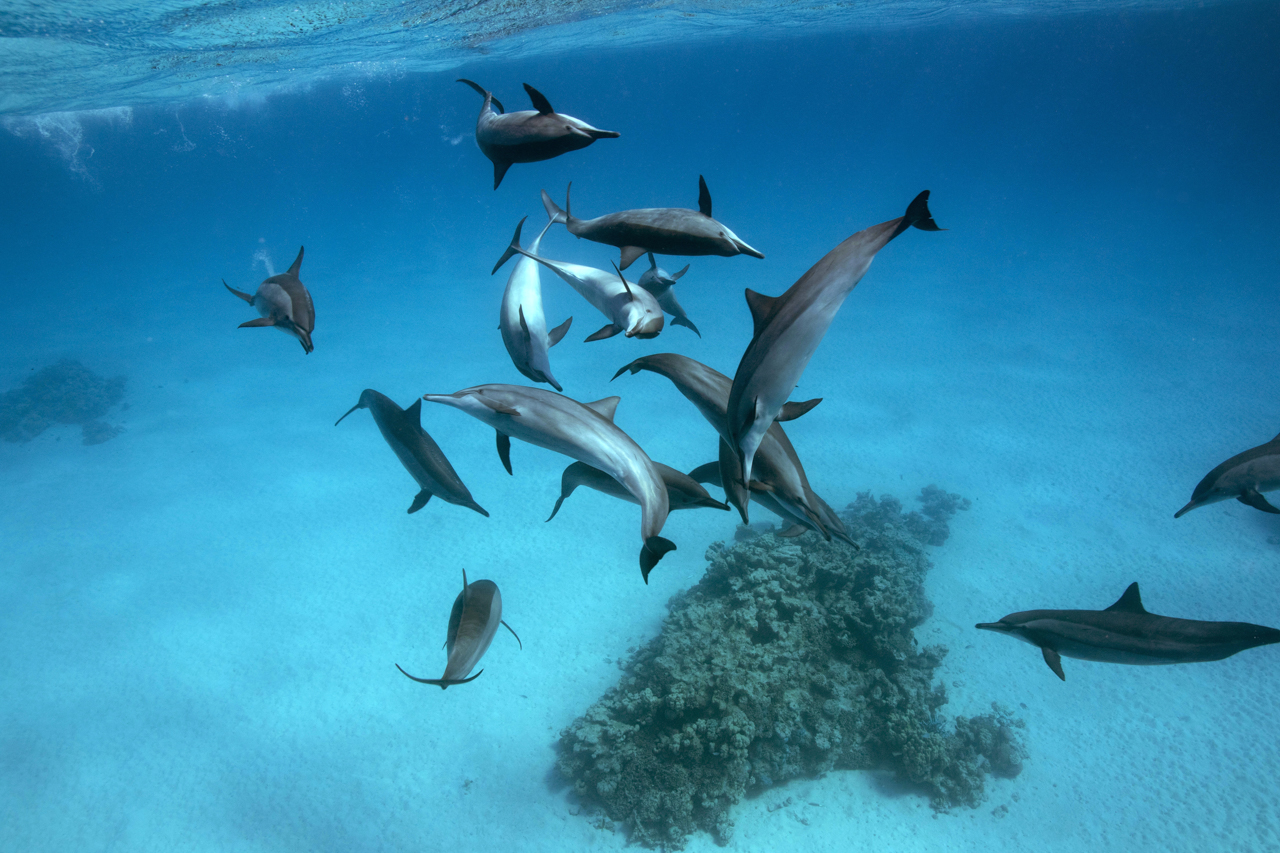
“Under the surface -- Split-Away in the shallows”
Spinner dolphins
Sataya, November 2019
My friends Denise, Tamiko, Jim and I followed a smaller group into shallow water – and it was worth every second.
The group had separated from the larger pod, making for more interesting viewing and better photographs.
The spinner dolphins of Sataya can be incredibly playful. They are fairly small, but exquisite, supremely agile and incredibly versatile.
One could spend hours watching them, enthralled and mystified – and we always do!
Split-away groups are always more intimate, both in terms of the dolphins and the people watching them, and it’s easier to notice individual characters.
Spinner dolphins
Sataya, November 2019
My friends Denise, Tamiko, Jim and I followed a smaller group into shallow water – and it was worth every second.
The group had separated from the larger pod, making for more interesting viewing and better photographs.
The spinner dolphins of Sataya can be incredibly playful. They are fairly small, but exquisite, supremely agile and incredibly versatile.
One could spend hours watching them, enthralled and mystified – and we always do!
Split-away groups are always more intimate, both in terms of the dolphins and the people watching them, and it’s easier to notice individual characters.

Spinner dolphins, adorable calf included, ascend.
Sataya, December 2019
Sataya, December 2019
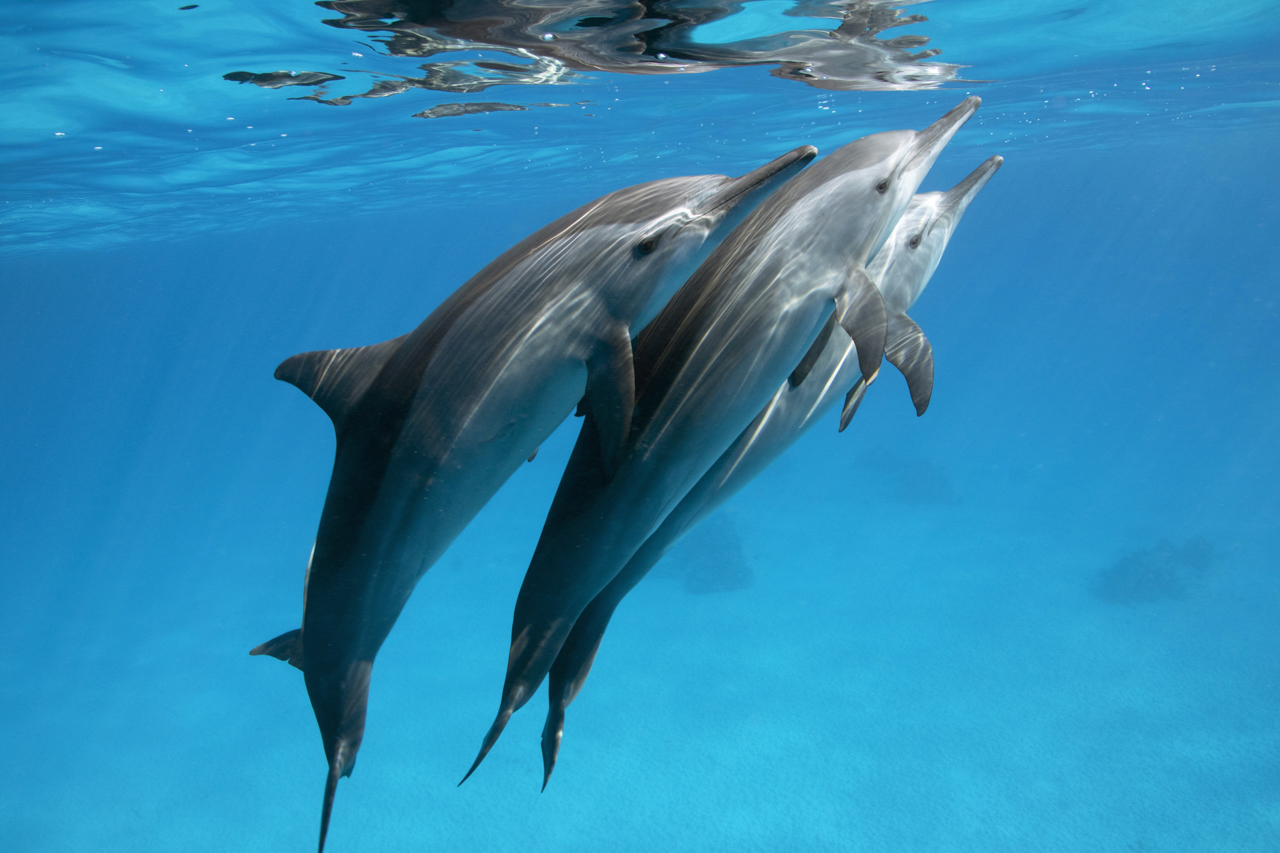
Independent thinkers/risers “en petit comité” split away from the rest of the spinner dolphin pod
Sataya, December 2019
Sataya, December 2019
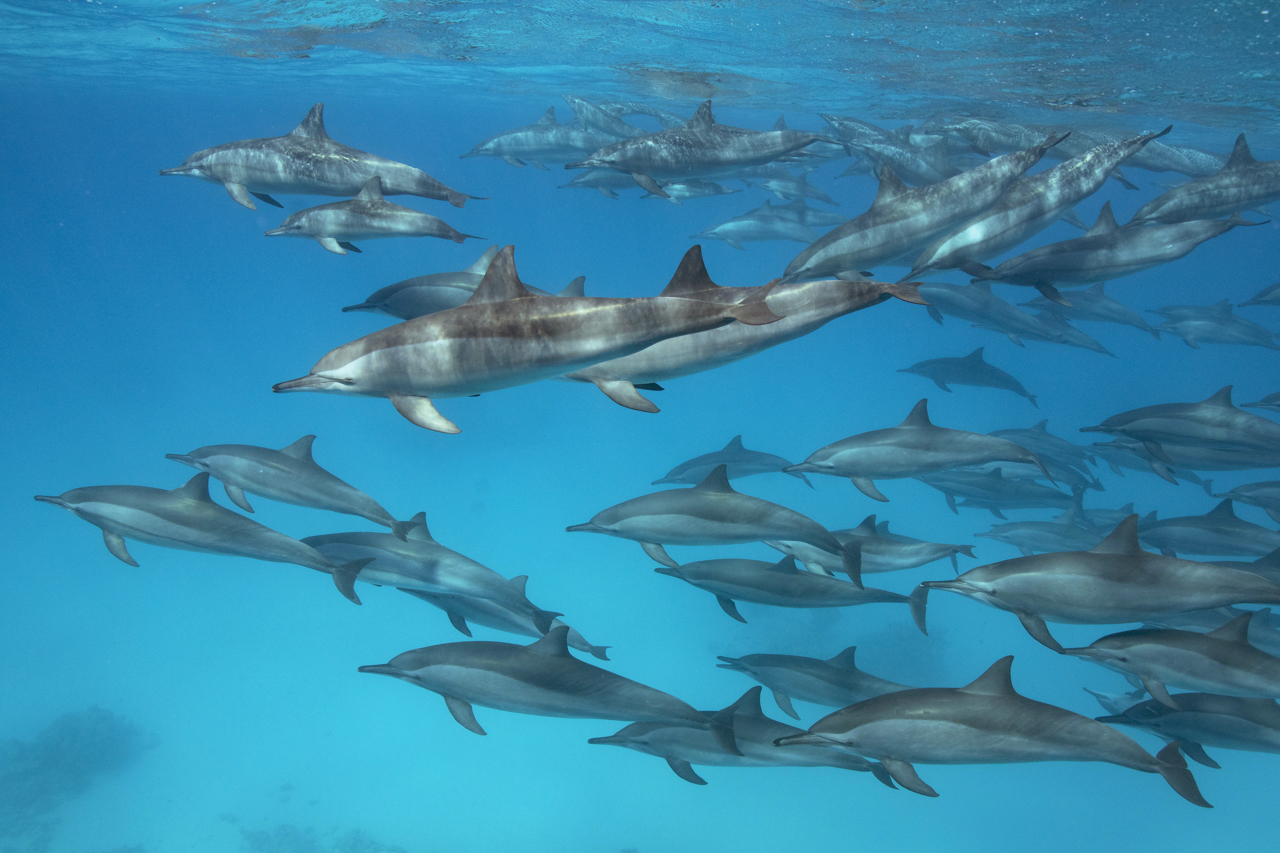
Spinner dolphins in formation
Sataya, December 2019
Sataya, December 2019

